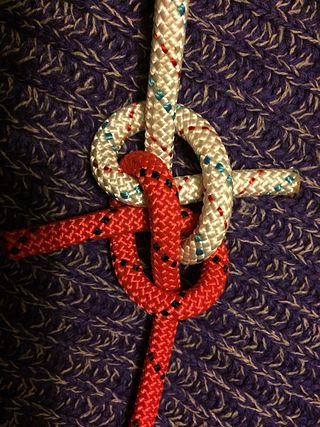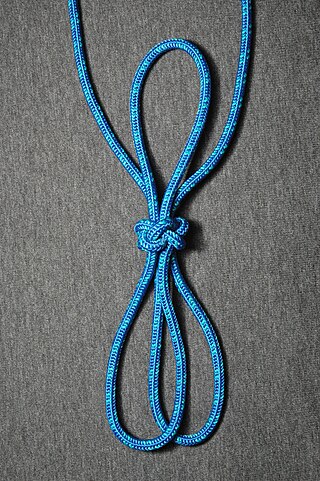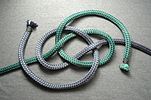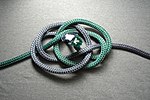
A knot is an intentional complication in cordage which may be practical or decorative, or both. Practical knots are classified by function, including hitches, bends, loop knots, and splices: a hitch fastens a rope to another object; a bend fastens two ends of a rope to each another; a loop knot is any knot creating a loop; and splice denotes any multi-strand knot, including bends and loops. A knot may also refer, in the strictest sense, to a stopper or knob at the end of a rope to keep that end from slipping through a grommet or eye. Knots have excited interest since ancient times for their practical uses, as well as their topological intricacy, studied in the area of mathematics known as knot theory.

The constrictor knot is one of the most effective binding knots. Simple and secure, it is a harsh knot that can be difficult or impossible to untie once tightened. It is made similarly to a clove hitch but with one end passed under the other, forming an overhand knot under a riding turn. The double constrictor knot is an even more robust variation that features two riding turns.

A shank is a type of knot that is used to shorten a rope or take up slack, such as the sheepshank. The sheepshank knot is not stable. It will fall apart under too much load or too little load.

The figure-eight knot or figure-of-eight knot is a type of stopper knot. It is very important in both sailing and rock climbing as a method of stopping ropes from running out of retaining devices. Like the overhand knot, which will jam under strain, often requiring the rope to be cut, the figure-eight will also jam, but is usually more easily undone than the overhand knot.
The figure-eight or figure-of-eight knot is also called the Flemish knot. The name figure-of-eight knot appears in Lever's Sheet Anchor; or, a Key to Rigging. The word "of" is nowadays usually omitted. The knot is the sailor's common single-strand stopper knot and is tied in the ends of tackle falls and running rigging, unless the latter is fitted with monkey's tails. It is used about ship wherever a temporary stopper knot is required. The figure-eight is much easier to untie than the overhand, it does not have the same tendency to jam and so injure the fiber, and is larger, stronger, and equally secure.
A whipping knot or whipping is a binding of marline twine or whipcord around the end of a rope to prevent its natural tendency to fray.

A zeppelin bend is an end-to-end joining knot formed by two symmetrically interlinked overhand knots. It is stable, secure, and highly resistant to jamming. It is also resistant to the effects of slack shaking and cyclic loading.

A grief knot is a knot which combines the features of a granny knot and a thief knot, producing a result which is not generally useful for working purposes. The word grief does not carry its usual meaning but is a portmanteau of granny and thief.

The heaving line bend is a knot for securely joining two ropes of different diameter or rigidity. It is often used to affix playing strings to the thick silk eyes of an anchorage knot in some stringed instruments. In nautical use, the heaving line bend is used to connect a lighter messenger line to a hawser when mooring ships. It is knot number 1463 in The Ashley Book of Knots, and appeared in the 1916 Swedish knot manual Om Knutar.

The Carrick bend, also known as the Sailor's breastplate, is a knot used for joining two lines. It is particularly appropriate for very heavy rope or cable that is too large and stiff to be easily formed into other common bends. It will not jam even after carrying a significant load or being soaked with water.

A stopper knot is a knot that creates a fixed thicker point on an otherwise-uniform thickness rope for the purpose of preventing the rope, at that point, from slipping through a narrow passage, such as a hole in a block. To pass a rope through a block, or hole, is to reeve it. To pull it out is to unreeve it. Stopper knots prevent the rope from unreeving on its own.

A wall and crown knot is a decorative kind of rope button. The original use of the knot was to put at the end of the ropes on either side of a gangway leading onto a ship as stoppers.

A Matthew Walker knot is a decorative knot that is used to keep the end of a rope from fraying. It is tied by unraveling the strands of a twisted rope, knotting the strands together, then laying up the strands together again. It may also be tied using several separate cords, in which case it keeps the cords together in a bundle. The traditional use of the knot is to form a knob or "stopper" to prevent the end of the rope from passing through a hole, for instance in rigging the lanyards which tension the shrouds on older sailing ships with standing rigging of fibre cordage.

The fiador knot is a decorative, symmetrical knot used in equine applications to create items such as rope halters, hobbles, and components of the fiador on some hackamore designs. As traditionally described, it is a four strand diamond knot in which six of the eight ends loop back into the knot, thus allowing it to be tied with a single line. While a specific knot is discussed in this article, the fiador knot has also been treated as an entire class of multi-strand knots similarly made with a single line.

The basket weave knots are a family of bend and lanyard knots with a regular pattern of over–one, under–one. All of these knots are rectangular and lie in a plane. They are named after plait-woven baskets, which have a similar appearance.

The friendship knot is a decorative knot which is used to tie neckerchieves, lanyards and in Chinese knotting.

A carrick loop is a knot used to make a reliable and stable loop at the end of a rope formed by the tail turned around and attached to the main part using a carrick bend.

The Chinese button knot is essentially a knife lanyard knot where the lanyard loop is shortened to a minimum, i.e. tightened to the knot itself. There emerges therefore only two lines next to each other from the knot: the beginning and the end. The knot has traditionally been used as a button on clothes in Asia, thus the name.
The Chinese Button Knot is worn throughout China on underwear and night clothes. Buttons of this sort are more comfortable to lie on and to rest against compared to common bone and composition buttons, and they cannot be broken even by the laundry.
A Chinese tailor ties the knot without guide, flat on his table. But one may be more quickly and easily tied in hand by a modification of the sailor’s method of tying his knife lanyard knot (#787). The two knots are tied alike, but they are worked differently.

The Lapp knot is a type of bend. It has the same structure as the sheet bend, but the opposite ends are loaded. The slipped Lapp bend is also an exploding knot, which means that when pulling the quick release end it falls completely apart without further entanglement. It is as strong as or even stronger than the sheet bend, though much less common.





















